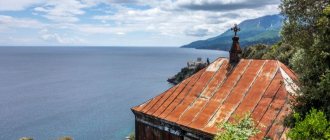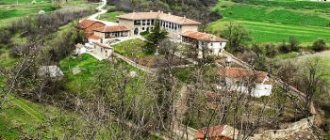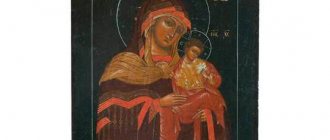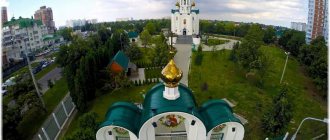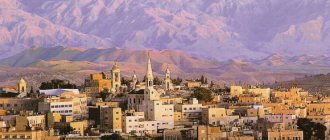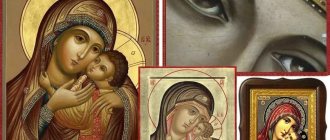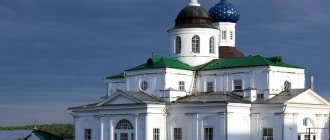Iveron Monastery on Mount Athos (Greece) - description, history, location. Exact address and website. Tourist reviews, photos and videos.
- Last minute tours
to Greece
The third most important and first in terms of the number of relics of saints, the monastery of Athos, Iveron, is inextricably, although indirectly, connected with our country: it was founded at the end of the 10th century by Saint John of Iveron, a native of Georgia, and built at the expense of the Bagration dynasty. It is from here that one of the most revered icons in Rus' comes from - the Iveron Mother of God, according to legend, painted during the life of the Virgin Mary by the Evangelist Luke. Despite the fact that in 1830 the monastery became Greek, and the Georgian inscriptions were replaced, everything here today reminds of Georgia: the architecture of the main cathedral with its “scalloped” dome, monastic buildings with suspended covered balconies on supports, just like in the old one Tbilisi, and ancient paving stones covering the courtyard.
The Iveron Monastery houses more than 150 relics of saints - more than anywhere else on Mount Athos.
A little history
The Iversky Monastery was founded in 980-983. Georgian monk John, who came from a noble Tiflis family. Together with their son Euthymius, they preached first in Constantinople, and then went to Athos, to the holy elder Athanasius, and served in the Great Lavra. Subsequently, Athanasius of Athos blessed the ascetics to found a new monastery - and so the Iveron monastery appeared on the holy mountain, named after the Russian name of the ancient Georgian kingdom of Iberia. Since then, the rulers of Georgia considered it their duty to help the Iveron Monastery, which saved the monastery from financial difficulties in the 15-16 centuries. In the 18th and 19th centuries, the monastery burned down three times, but was restored each time. In 1830, the monastery came under Greek control, and in 1955 the last Georgian monk died here.
The library of the Iversky Monastery contains the book of Psalms, donated to the monastery by Peter I.
Iveron Monastery on Mount Athos
Sights of New Athos
Let's start with the smallest. When you arrive in the center of New Athos, you see the Rakushka bus stop.
Bus stops in Abkhazia are concrete pavilions covered with mosaics of unusual shapes. Such original stops appeared in the second half of the 60s of the last century, the authors of the project are architect Georgy Chakhava, artists Zurab Kapanadze, Zurab Lezhava, Nodar Malazonia (although the authorship is sometimes attributed to Zurab Tsereteli). Now these stops are in varying states of preservation. Some are simply crying out for restoration.
“Shell” in New Athos is one of the best preserved.
Excursions in New Athos
What to see
Approaching the Iveron Monastery, you will definitely feel like you are somewhere in rural Georgia: and, it seems, the same picturesque mountains, and artless buildings, and the gray color of the stone walls, and the brick tiles covering the domes of the temples. The monastery is located on the coast, which rises quickly, growing into low hills; Monastery buildings seem to be molded to their base.
The main temple of the Iversky Monastery is consecrated in honor of the Dormition of the Blessed Virgin Mary. From the original building at the end of the 10th century, only the foundation and fragments of walls remained; the other structures were completed by 1513. The facade attracts the eye with a rich carmine color, on which the snow-white braiding of the windows stands out. In the interiors, it is worth seeing the magnificent frescoes of the 16th century and venerating the numerous relics of saints. The famous Iveron Icon of the Mother of God, dating back to the beginning of our era and belonging to the authorship of the Apostle Luke, can be seen in a separate small church on the territory of the monastery. According to legend, they repeatedly tried to move the icon to the Catholicon, but each time it returned to its place above the gate to the monastery, for which it received the nickname Goalkeeper.
Among the historical relics of the Iveron Monastery is the “lemon tree” - a silver candlestick with seven candles, and a door made of silver and ebony separating the vestibule and the central nave. The monastery library contains the book of Psalms, donated to the monastery by Peter I.
Iversky Monastery
| Iviron |
At a distance of approximately two hours from Philotheus there is the famous Iveron Monastery, the third in honor on the Holy Mountain.
The Iversky Monastery was founded at the end of the 10th century by immigrants from Iberia, the Venerables John, Euthymius and George, who came from the Bagratid dynasty. At a distance of approximately two hours from Philotheus there is the famous Iveron Monastery, the third in honor on the Holy Mountain.
The Iversky Monastery was founded at the end of the 10th century by immigrants from Iberia, the Venerables John, Euthymius and George, who came from the Bagratid dynasty. They were disciples of St. Athanasius and founded the monastery with his blessing. Since then, the Great Lavra and the Iversky Monastery have been considered twin monasteries. Some scientists consider the founder of the monastery to be another native of Iberia, the Byzantine military man Tornikius.
For a long time, mainly Georgian monks labored in Iviron; the last of them died in 1955. At the moment, Greeks predominate among the inhabitants of the monastery.
The first builders of the monastery and subsequent generations of inhabitants of Iviron did not leave their compatriots in their care. Thus, the Monk Euthymius translated the Holy Gospel and other soul-helping books into Georgian.
| Klimentova pier |
Iviron was built on the site where the Lavra of Clement was previously located.
It was in this monastery, immediately after the death of St. Peter of Athos, that his Holy relics were exhibited for veneration. On the territory of the monastery there was a pagan temple of Poseidon, which was rebuilt and consecrated in honor of the prophet and baptist John. According to legend, it was founded during the reign of Constantine the Great and the first bishop of Athos, Clement, and restored during the reign of Constantine Pogonatus. The current temple was rebuilt in 1710. In its place, during excavations, ancient frescoes of the Cathedral of the Lavra of Clement were found. Not far from the monastery on the seashore, a miraculous spring has been preserved to this day, flowing at the moment when the Mother of God set foot on Athos soil; this place is called Klimentova pier. And it was to this place that the Iveron Icon of the Mother of God, now known to the whole world, miraculously, in a pillar of fire, appeared across the sea. The veneration of this image is evidenced by the fact that only the Monk Nicodemus the Holy Mountain wrote four canons to the Iveron Icon of the Mother of God.
| Miraculous Icon of the Mother of God of Iveron |
During the time of iconoclasm, the widow, the owner of this icon, who lived near the city of Nicaea, saving the image from desecration, sent it flying across the waves with prayer.
Several centuries have passed. And so, in 1004, he miraculously, in a pillar of light rising to the very heavens, arrived at the shores of Athos. At this time, the pious elder Gabriel had a vision of the Mother of God, who commanded him to approach the icon on the water and transfer it to the cathedral church. In honor of the miraculous appearance of the icon, the Church of the Dormition of the Blessed Virgin Mary has now been erected. The icon was placed in the altar of the church of the Iversky Monastery, but the next morning it ended up above the gates of the monastery. This went on for several days. The Mother of God appeared in a dream to the elder of the monastery and said:
I do not want to be protected by you, but I want to be your Guardian... As long as you see My image in this monastery, until then the grace and mercy of My Son towards you will not fail.
Then the miraculous icon was placed above the gates of the monastery and began to be called “The Goalkeeper.”
Once, during a Saracen raid, one barbarian boldly hit the icon with his spear. At that same moment, blood flowed from the image, which can still be seen on it today. The robber repented and became a monk under the name of Damascus, but he called himself a Barbarian. The monk achieved holiness, and his iconographic image was preserved in the monastery.
In 1651, Russian Tsar Alexei Mikhailovich gave Iviron the Monastery of St. Nicholas in the Moscow Kremlin. This was done in gratitude for the healing of the Tsar’s daughter, who received healing from the list of “Goalkeepers” brought by the inhabitants of the Iveron Monastery to Moscow.
Here is what the famous Russian pilgrim-pedestrian of the 18th century Vasily Grigorovich-Barsky writes about “The Goalkeeper”:
“In this beautiful church, at the inner gates of the monastery, in the iconostasis, instead of the usual Mother of God, there is a certain holy and miraculous icon, named by the ancient monks Portaitissa, that is, the Goalkeeper, extremely terribly transparent, with great feathers, holding Christ the Savior on her left hand , blackened on the face for many years, both completely showing the image, everything except the face is covered with silver-plated gilded clothing, and in addition, dotted with valuable stones and gold coins, from various kings, princes and noble boyars given for many of her miracles, where and I saw Russian tsars, queens and princesses, emperors and empresses, princes and princesses, gold coins and other gifts hung with my own eyes.”
| Inner territory of Iviron |
The tradition of the monastery tells of a miracle performed by the Mother of God.
One poor man asked to spend the night in Iviron, but the monk-goalkeeper demanded payment from him. The poor man had no money, and, dejected, he went along the road to Kareya. Soon he met a mysterious Woman who gave him a gold coin. The poor man returned and gave the gold coin to the gatekeeper. The monks, paying attention to the antiquity of the coin, suspected the unfortunate man of theft. After his story about the Wife, they went to the “Goalkeeper” icon and saw that this coin was one of many donated to the Mother of God. The repentance of the monks was great. Since then, the vow of free hospitality has been strictly observed on the Holy Mountain. And at the site of the appearance of the Mother of God, a small temple was built, which you can walk to in 10–15 minutes. The Russian saint Parthenius testified that during the Greek uprising of 1822, Turkish soldiers living in the monastery were unable to disturb the “Goalkeeper” dressed in precious vestments and decorated with many magnificent gifts. And a few years later, the monk serving at the icon was amazed to see a Woman dressed in black. She diligently swept the monastery.
It's time to thoroughly sweep the entire monastery. For so many years he has been standing unmarked, -
said the Woman and became invisible.
Soon the Sultan issued a decree for all soldiers to leave the Holy Mountain, although before that he had repeatedly threatened to destroy its monastery to the ground.
| Procession with the Iveron Icon of the Mother of God |
The “Goalkeeper” herself never left Iviron; in response to requests from the laity, the monks sent lists of the miraculous image.
The icon is taken out of the paraklis only three times a year, where it remains constantly: - on the eve of the Nativity of Christ, after the ninth hour, it is solemnly transferred by the brethren to the cathedral and remains there until the first Monday after the feast of the Council of John the Baptist;
- from Holy Saturday to Monday of St. Thomas Week. On Tuesday of Bright Week a solemn procession of the Cross takes place through the territory of the monastery;
- on the Assumption of the Blessed Virgin Mary.
The Iversky Monastery provided very large financial assistance to the Greeks who rebelled against Turkish rule. The monks donated some historical relics of their monastery to the needs of the liberation movement. Including a unique silver gilded candlestick in the shape of a lemon tree weighing more than sixty kilograms. The rebels, however, refused the gift and returned the candlestick to the monastery so that “it would burn in front of the icon of the Mother of God for the Orthodox people.” The history of this relic is interesting. The lemon tree was given to Iviron by the residents of Moscow, as evidenced by a poem in Russian embossed on the candlestick. The inscription also indicates the date of the donation – April 30, 1818.
The fate of the holy martyr Patriarch Gregory V is closely connected with Iviron. Near the monastery, on the site of the cell where he labored for sixteen years, a paraklis was erected in his honor.
| “Don’t cry for Me, Mati” (fresco of the first half of the 16th century) |
According to legend, before the end of the world, Athos will plunge into the abyss of passions.
And then the icon will leave the Holy Mountain in the same miraculous way as it appeared. This will be one of the omens of the imminent Second Coming of the Savior and a sign for the Holy Mountain residents to leave Athos. Nowadays the miraculous icon resides in a special paraclis of Panagia-Portaitissa, located on the left hand of the entrance to the holy monastery. It was built in the 17th century, and the famous paintings in its narthex date back to 1774. In particular, they depict: Plato, Aristotle, Sophocles, Thucydides, Plutarch, Alexander the Great. In front of the iconostasis, built in 1785, is the miraculous icon of the Mother of God. Portaitissa has a gilded silver frame made in Moscow in 1819. Below it is an older frame from 1701, made in Iveria. In the Portaitissa area there is a miraculous icon of St. Nicholas, which miraculously arrived from Russia in June 1815. It is interesting that Iviron, unlike other Svyatogorsk monasteries, does not use Byzantine time, but inherited its own time system from the founders of the monastery. According to it, the day begins not with sunset, but with sunrise.
The main cathedral of the monastery was founded at the end of the 10th century. The construction was completed under Abbot George, as evidenced by the surviving inscription on the sole. The cathedral church was restored in the 16th and 19th centuries, but much has been preserved from the first catholicon. It is also worth paying attention to the frescoes painted in 1522. Their author is monk Mark, originally from Iberia. His joint image with Abbot Gabriel has been preserved on a fresco in the eastern part of the cathedral. Above the royal doors there is a wonderful lamp. It begins to sway, so much so that even oil sometimes splashes out over the edges - either on the eve of great holidays, or on the eve of world upheavals. This is how the Most Holy Theotokos reminds people of her presence and intercession and calls them to repentance. The main cathedral of Iviron has two chapels: St. Nicholas and the Holy Heavenly Powers of the Ethereal. The latter houses most of the monastery’s shrines.
In Iviron, perhaps, the largest number of relics of the saints of God and other shrines are collected. Let us mention the parts of the chlamys, the cane and the lips with which the Lord Jesus Christ was abused by the Jews; part of the Life-giving Cross of the Lord, particles of the relics of the Forerunner and Baptist of the Lord John, right. Lazarus of the Four Days, St. App. Peter, Luke and Bartholomew, the first martyr. Archdeacon Stephen, St. Basil the Great, John Chrysostom, martyr. St. George the Victorious, healer Panteleimon, Mercury and Demetrius of Thessalonica, sschmchch. Vasily, bishop Amasia, and Theodore, also in Perga, martyr. Nikita, Photius and Nestor, St. Michael Bishop Sinadsky and Athanasius the Great, mcc. Photinia, Eupraxia, Anastasia and Paraskeva, Venerables. Theodore Stratelates and Hierotheus of Iveron and many other saints.
A historical relic is the sakkos (the main part of the festive attire) of the Byzantine emperor John Tzimiskes. Among the artistic attractions, the most impressive are the Persian-style chandelier, two ancient Greek columns from the Temple of Poseidon, which once stood on this site, and a golden lemon tree with silver leaves, made in Russia.
In the northwestern corner of the cathedral church there is a striking fresco depicting the Lord Jesus Christ in full height. Monastic tradition claims that someone prayed long and earnestly to God, asking to reveal the Savior in incarnate form, and a secret voice announced to the persistent prayer book:
Go to Mount Athos, to the Iveron Monastery. There, at the northern door leading into the vestibule of the cathedral, you will find My exact full-length image .
After venerating the monastery shrines (this can be done at any time of the day), you can stay in the monastery for the night and walk around the picturesque surroundings of the monastery, visiting the mentioned places of the appearance of the Mother of God, but you can also continue your journey towards Kareya. It can be easily reached there by frequent passing transport. If you wish, you can also head to the Stavronikita monastery, clearly visible from the Iverskaya pier.
Iverskaya Mountain, Anakopia Fortress
Passing the monastery and the cave, we finally climbed the Iverskaya Mountain. According to an ancient legend, it was here that in ancient times there was a miraculous icon of the Mother of God, who saved the rulers of Abkhazia from Arab warriors.
Anakopia fortress
Anakopia fortress
Anakopia fortress
Anakopia fortress
Before going up to the Anakopia fortress, be sure to stock up on a bottle of water. By the way, it was not so easy for me to climb to a height of 340 meters above sea level. Again, I remembered my not entirely healthy lifestyle.
However, having looked around, the fatigue disappeared somewhere, because a simply breathtaking view of the sea and hills opened up all around. After catching our breath, drinking water, and taking photographs, we went to the ancient walls of the Anakopia fortress. Several defensive lines along with the outer defensive line occupied about 65,000 square meters. meters of area. The walls of the first line reached a width of 1 meter. Impressive, isn't it?!
Anakopia fortress
Anakopia fortress
Anakopia fortress
Anakopia fortress
Anakopia fortress
Anakopia fortress
While I was enjoying its grandeur, my little son ran to look at the inexhaustible well, built by the builders of Anakopia, carved out of the rock. If in ancient times it was fed by rainwater, now it is condensation on the cold walls of the tank. This is where the bottle we had stored came in handy; we filled it with cool water, because there was still a long way back ahead.
Abkhazia
Abkhazia
Abkhazia
Abkhazia
By the way, we also visited the Primorsky Park with a system of ponds fed by the waters of the Psyrtskhi River (the famous lake with swans), and walked along the famous Path of Sinners. It is believed that a person who walks along it is freed from all sins. Well, let's believe that from now on I am sinless.
The station is abandoned
The station is abandoned
Abkhazia
Abkhazia
Abkhazia
Abkhazia
Return
Photo from diveevo.ru
In 1995, the Iveron Chapel was restored and solemnly consecrated by Patriarch Alexy II.
For the restored chapel, Hieromonk Luke from the Athonite monastery of Xenophon wrote a new copy of the “Goalkeeper”. Before the icon, an akathist is read daily by Moscow priests in order.
There is a known list of the Iveron Icon from the Valdai Iveron Monastery. The monastery was founded by Patriarch Nikon, who asked Iviron to send him another copy of the “Goalkeeper” icon, which was done around 1655. The icon was met in Valdai on February 12, 1656. This is where the tradition of the second Russian holiday in honor of the Iveron Icon came from - February 12 (25) . After the revolution, the list disappeared and has not yet been found. The icon shown in the photo is more recent.
Church of St. Theodora
At the very top of the Anakopia Mountain there are the ruins of an ancient temple named after St. Theodore. The building was once a room with one nave, an eastern apse, and a rectangular vestibule. The plan of the temple today can only be judged from the remains of the foundation. The building underwent a large-scale reconstruction: the temple was shortened, the masonry was expanded inside and outside, the facades were faced with limestone slabs, some apse windows were blocked, pylons and seven arches were added to the interior, supporting a stone vault. At the same time, a new chapel appeared in the church on the south side, which could have memorial significance.
Shrine of Moscow
Chapel of the Iveron Mother of God.
Moscow, 1910. Photo from the site retromap.ru The Moscow copy of the Iveron Icon was placed in the chapel at the Resurrection Gate of the Kremlin. Archbishop Arseny (Zhadanovsky) recalled: “The chapel was surrounded by Muscovites all day long. At nine o’clock in the evening it was locked, but this did not distract the attention of the pilgrims, who continued to stand in anticipation of the night vigil.”
The image was often taken out of the chapel for worship and to go around houses, especially during epidemics.
During her absence, replacement icons were displayed in the chapel for veneration.
Alexander Vertinsky in his memoirs “The Long Road...” tells how Iverskaya carried flowers to Iverskaya as a poor student: “Iverskaya was the religious center of Moscow. In a small chapel near Red Square stood her icon, illuminated by hundreds of candles lit by believers. The icon sparkled with diamonds, emeralds and rubies, which were donated by those healed of various ailments and sorrows, hardships and suffering. It all started with her. Not a single visiting merchant began business without bowing to Iverskaya...
We also sometimes brought our modest gifts to the icon. I remember how before big events, exams for example, my friends and I would go to Iverskaya and light candles or buy white roses on long stems and put them in candlesticks.”
During the Soviet years, the Iverskaya Chapel was destroyed. The fate of “that same” Iveron icon is still unclear.
Recently, more and more historians and art historians are inclined to believe that “that same” Moscow Iveron Icon of God, the image of which was painted in the 17th century specifically for the Russian capital, is now in the State Tretyakov Gallery.
The Church of the Resurrection of Christ in Sokolniki also houses an image of the Iveron Mother of God. The question remains open whether this icon is the Moscow Iverskaya or a substitute image.
Another replacement image from the Iveron Chapel is in Paris. It was taken to France in 1812 by an officer of Napoleon's retreating army and unexpectedly discovered in an antique shop by a Russian emigrant in 1930 and bought in 1932 through the enormous efforts of emigration, in particular the famous ascetic Bishop Veniamin (Fedchenkov, later Metropolitan).
The Parisian Iveron Icon is now kept in the Three Saints Metochion (Rue Petel, 5), where an akathist is read before it on Wednesdays. There are revered Iveron icons in other well-known parishes of the first wave of Russian emigration. For example, in the Church of St. Nicholas at Via Palestra 69 in Rome.
New Athos Cave
The ticket office is located in the lobby. The decoration of the ticket office (arrival hall) is impressive. From the souvenir shops I wanted to take knives, figurines, and jewelry as souvenirs! But, alas, the prices there are a little beyond reasonable...
Train to the caves of Abkhazia
Train to the caves of Abkhazia
Train to the caves of Abkhazia
Train to the caves of Abkhazia
You can go down on a special train that departs from the mini-metro platform. By the way, we paid for photo/video shooting right at the entrance. Not far from the entrance to the cave you can see stones with “red stains of the apostle’s blood.” It’s quite warm inside – about +11 °C; many red helictites growing on the ceiling dilute the darkness. Some halls are rich in lakes and waterfalls. There are 9 halls in the cave, but usually 6 are visited.
New Athos caves
New Athos caves
New Athos caves
New Athos caves
I would like to say a few words to parents who take small children with them to the cave. Eye and eye! I lost mine three times because my son was so captivated by the underground beauty that he ran a couple of meters away from me. In the last minutes of our stay underground, he and I walked exclusively holding hands, which is what I advise you to do!
After the excursion to the cave, I made a couple of observations. Firstly, there is a lot of fungus and mold here. But this indicates that the cave ecology is in a terrible state. The second observation shocked me even more. We are talking about “cultural” visitors who consider it their duty to tear off part of a stalactite or stalagmite as a souvenir. Do you know that 100 years pass before a stalagmite or stalactite increases by just 1mm?!

